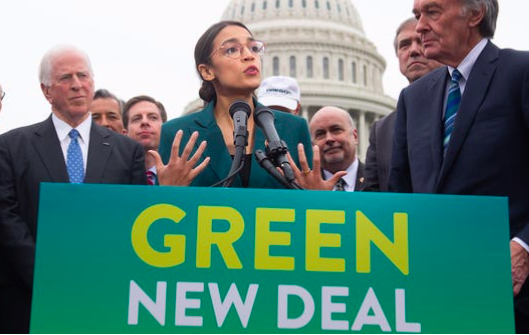R. A.
The Green New Deal comes with a reality of the pressures of fake news on the general public. An example of this has to do with cost. Almost seventy percent of Americans would support action to prevent climate change. But how much are people are willing to pay for these measures in taxes? Only about a third of Americans would support the same regulations if they came with even a $100 tax increase. On September 20, 2019, the Florida Republican Party played on this source of division. They tweeted that as a result of the Green New Deal, each American household would have to contribute $600,000. This number is false, because the Green New Deal has not been finalized into specific measures. This makes it so that the Green New Deal has fake news qualities. Therefore it cannot be referenced in the way it would need to be in order to avoid these fallacies.
Critics have also claimed that the Green New Deal would end air travel. However, the resolution does not even mention airplanes. Instead, it calls for large transportation systems to eliminate as much pollution and greenhouse gas emissions as technologically possible. If enacted, the Green New Deal would not drastically change our current modes of transportation. Rather, it simply calls for them to become more sustainable.
Believing fake news about the Green New Deal does not make sense in a time when the effects of climate change are so prevalent. These effects can be seen in several capacities. They can be recognized in the rise of sea levels, warming of the ocean, rise in global temperature, extreme weather events, and much more.
So why are some Americans so opposed to the Green New Deal? From costs to changes in transportation, people are very willing to dismiss the ideas it proposes entirely. The fear remains that in order to combat climate change; individuals will have to drastically alter their ways of life. Ultimately, the Green New Deal does not refer to just one proposal. Instead, it is a set of goals for the future. Overall, it is a vision attempting help stop climate change, create new jobs, and protect particularly vulnerable communities.
Interestingly, this is not the first time a proposal such as the Green New Deal has faced so much controversy. When President Franklin D. Roosevelt proposed the New Deal to lift the United States out of the Great Depression, much of the American media opposed it.[1] At the time, about 85 percent of the conservative press challenged the New Deal. Early coverage of the Depression did not convey the gravity of the situation. With this problem, it was difficult to find useful information about the New Deal in newspapers.
Fake news surrounding the Green New Deal has proliferated. The distinction is that in the 1930s, conservatives’ monopoly over the press limited information about the New Deal even though the measures themselves were specific. However, the current problem with the Green New Deal is that the factual information exists and is even readily available to the public, but people are not looking for it. However, the vagueness of the “Green New Deal” is also a source of many fallacies associated with it. This is the reason conservative groups such as the Florida GOP are able to make wild claims, and some individuals are eager to believe it. The way we receive information also contributes greatly to this. In our current fast paced media we often forget to fact check our sources. This false information intends to discredit and further convolute the legislation before it has even had a chance to be adequately proposed. Both of these work in conjunction with one another, because if the green new deal were more specific then fake news surrounding it would be less believed. The historical context of the New Deal helps us to see just how difficult it can be to find support in such a misinformed media. Unfortunately, the result is a society that does not fully understand the magnitude of what is happening. In the past it was the Great Depression and now it is the effects of climate change.
Americans have been prevented from accepting the Green New Deal even though most support its reforms. In part, complacency with consumption of false media has led to this problem. Further, there is a fear of cost and a consideration for current transportation. There is also vagueness in the goals of the Green New Deal in that it is not all encompassing and specific. The result is a lack of trust in the Green New Deal and thus a lack of action toward making it a reality. These two cases show how people are more interested in keeping the luxuries of their day-to-day lives than in actually taking action. It is a fear of change that promotes inaction. Such a view is common in a society so exposed to fake news.
[1] Sam Lebovic, Media Nation (University of Pennsylvania Press 2017)
